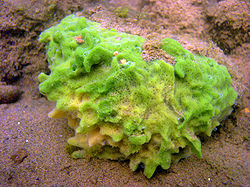Spongilla
| Spongilla | |
|---|---|

| |
| Scientific classification | |
| Kingdom: | |
| Phylum: | |
| Class: | |
| Order: | |
| Family: | |
| Genus: | Spongilla |
| Species | |
|
See text | |
Spongilla is a genus of freshwater sponges in the family Spongillidae found in lakes and slow streams. Sponges of the genus Spongilla attach themselves to rocks and logs and filter the water for various small aquatic organisms such as protozoans, bacteria, and other free-floating pond life. Unlike marine sponges, freshwater sponges are exposed to far more adverse and variable environmental conditions, so they have developed gemmules as a means of dormancy. When exposed to excessively cold or otherwise harsh situations, the sponges form these gemmules, which are highly resistant "buds" that can live dormant after the mother sponge has died. When conditions improve, the gemmules "germinate" and a new sponge is born.
Spongilla was used by John Hogg in the 19th century to attempt to justify a fourth kingdom of life.[3]
Species
- Spongilla alba
- Spongilla arctica
- Spongilla aspinosa
- Spongilla benguelensis
- Spongilla cenota
- Spongilla chaohuensis
- Spongilla dawson
- Spongilla friabilis
- Spongilla gutenbergiana
- Spongilla helvetica
- Spongilla inarmata
- Spongilla jiujiangensis
- Spongilla lacustris
- Spongilla permixta
- Spongilla prespensis
- Spongilla sarasinorum
- Spongilla shikaribensis
- Spongilla stankovici
- Spongilla wagneri
References
- ^ van Soest, R. (2014). Van Soest RW, Boury-Esnault N, Hooper JN, Rützler K, de Voogd NJ, de Glasby BA, Hajdu E, Pisera AB, Manconi R, Schoenberg C, Janussen D, Tabachnick KR, Klautau M, Picton B, Kelly M, Vacelet J (eds.). "Spongillidae Gray, 1867". World Porifera database. World Register of Marine Species. Retrieved 2014-05-22.
- ^ van Soest, R. (2014). Van Soest RW, Boury-Esnault N, Hooper JN, Rützler K, de Voogd NJ, de Glasby BA, Hajdu E, Pisera AB, Manconi R, Schoenberg C, Janussen D, Tabachnick KR, Klautau M, Picton B, Kelly M, Vacelet J (eds.). "Spongilla Lamarck, 1816". World Porifera database. World Register of Marine Species. Retrieved 2014-05-22.
- ^ Hogg, John (1860), "On the distinctions of a plant and an animal and on a fourth kingdom of Nature", Edinb N Phil J (N Ser), 12: 216–225
- Myers, P., R. Espinosa, C. S. Parr, T. Jones, G. S. Hammond, and T. A. Dewey. 2006. The Animal Diversity Web (online). Accessed February 19, 2007 at http://animaldiversity.org.
- "freshwater sponge". Encyclopædia Britannica Online. Retrieved 2014-05-22.
- Protozoa and Invertebrates Manual. Burlington NC: Carolina Biological Supply Company. 1980. p. 15. ISBN 978-0892780365.
